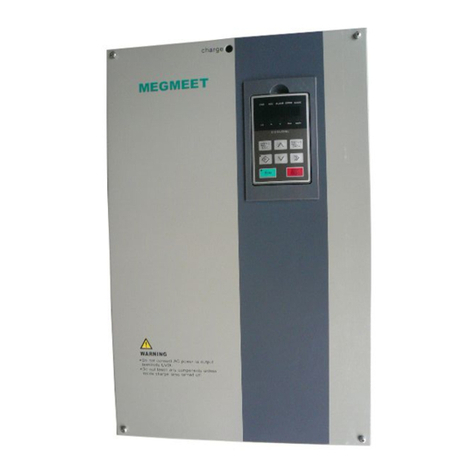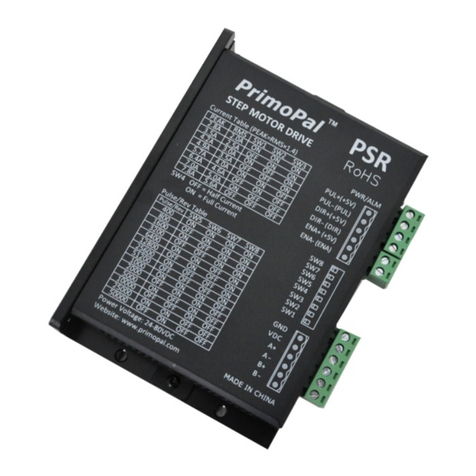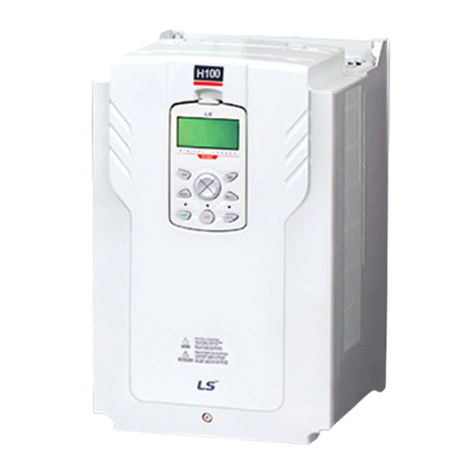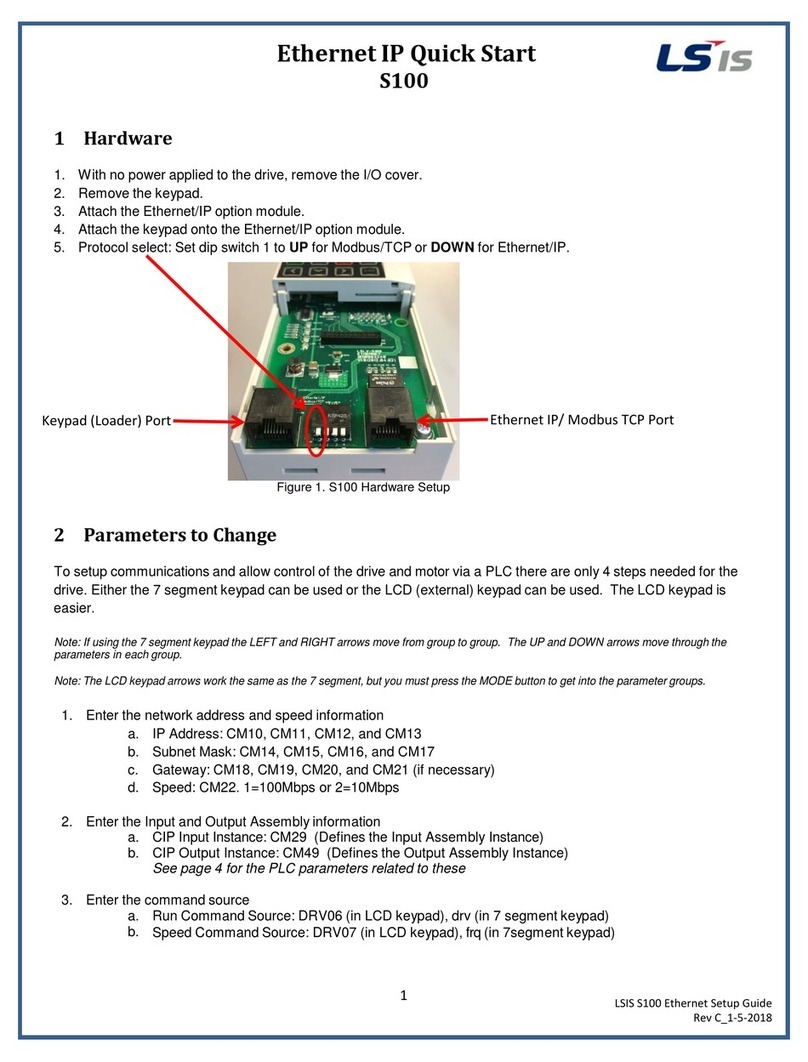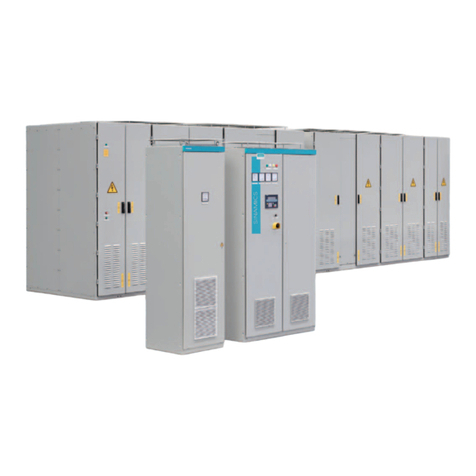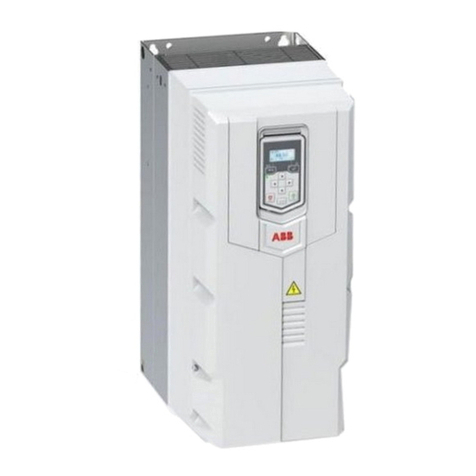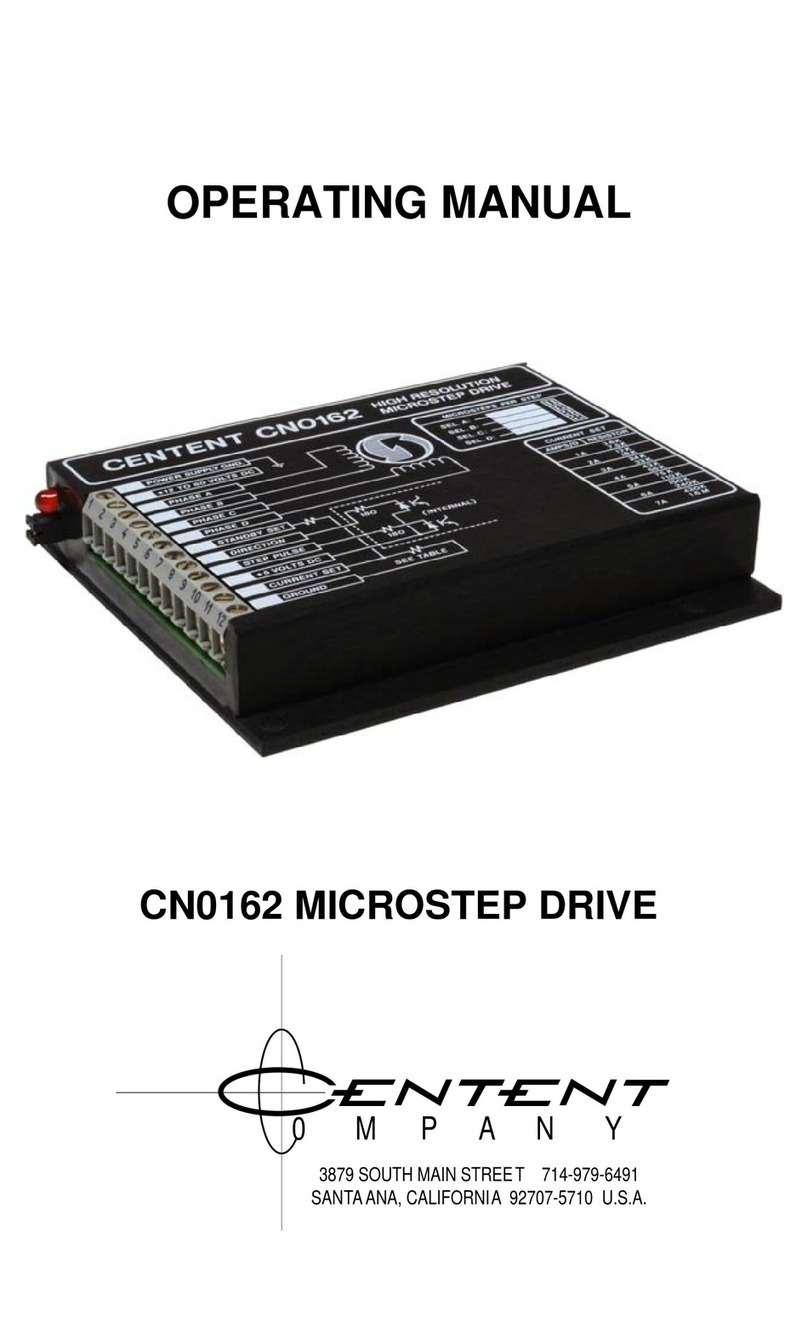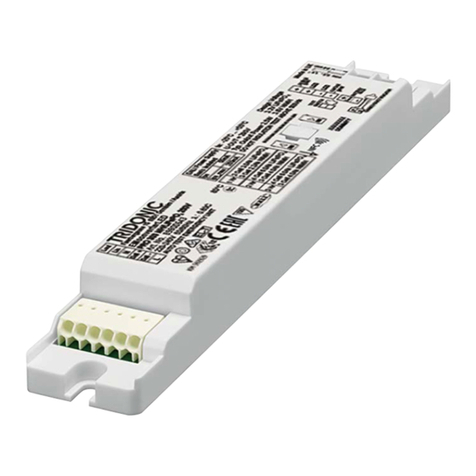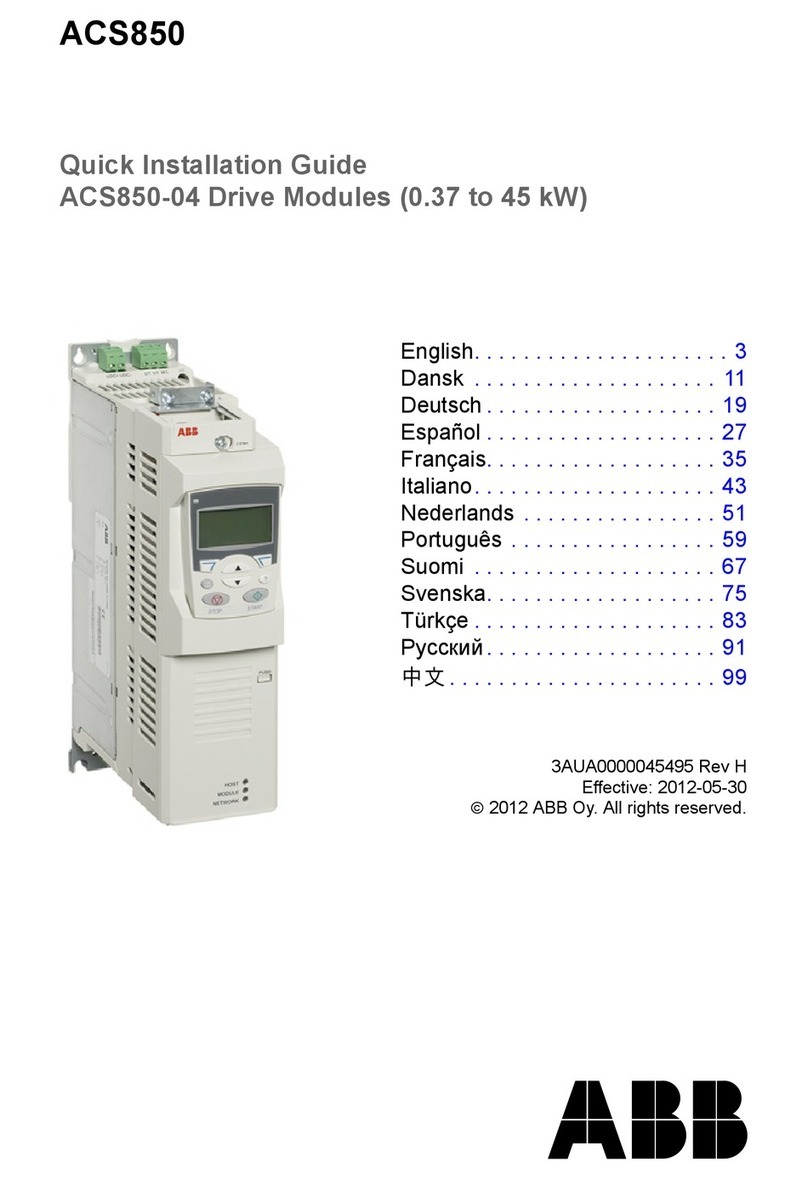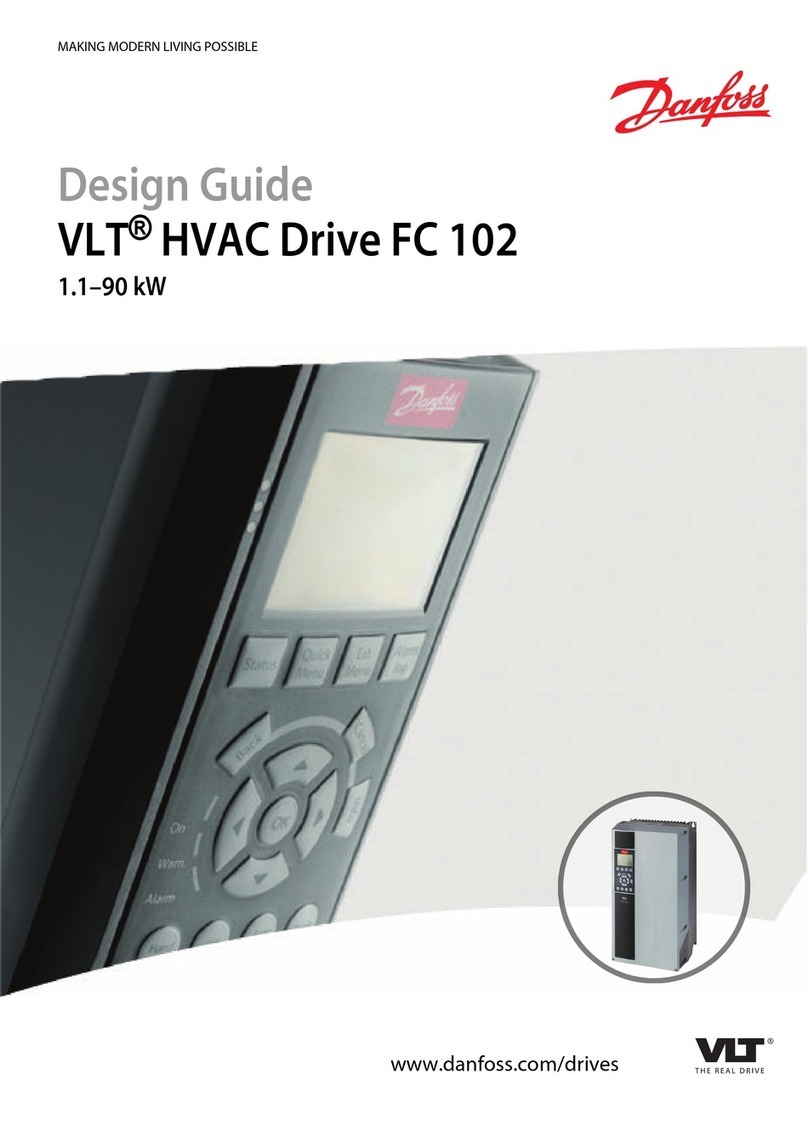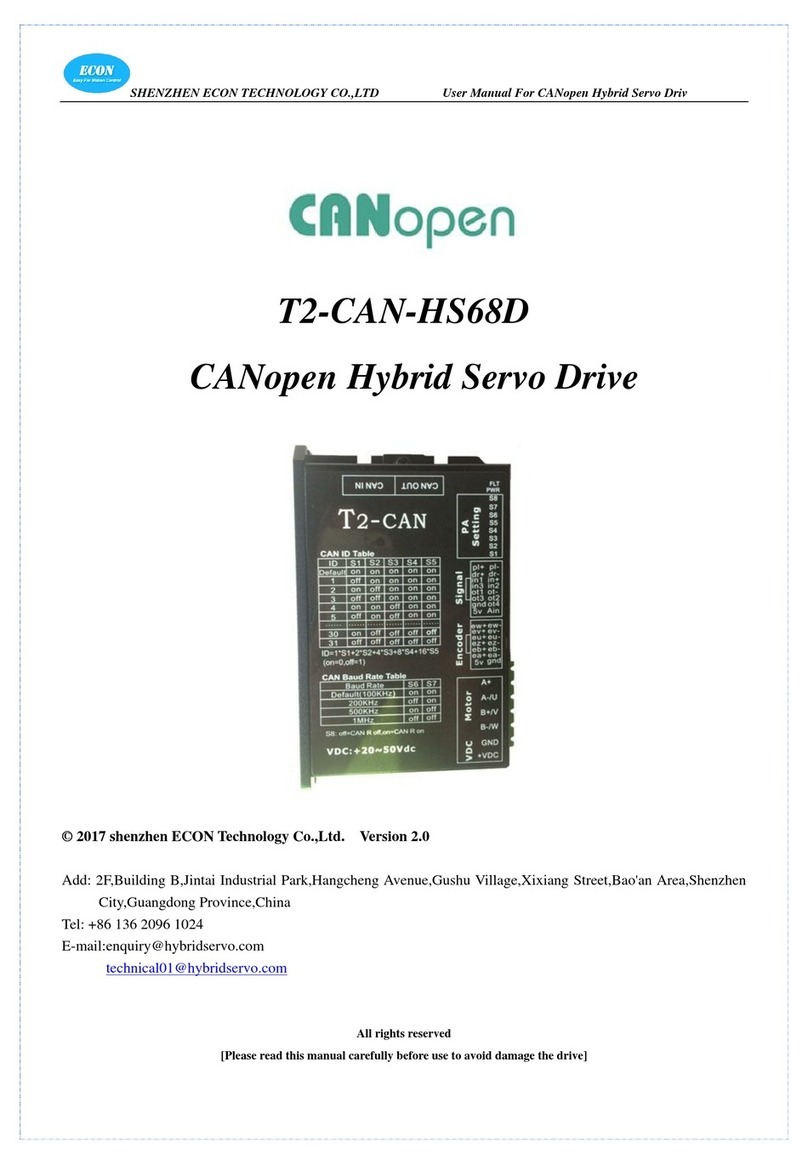Shihlin electric SME Series User manual

i
Safety Precautions
Thank you for purchasing Shihlin Electric product. This user manual introduces how to install,
wiring, inspect and operate Shihlin Servo Drive and Motor. Please read related items in this
user manual prior to installation and operation for safety.
■There are 2 safety notification levels in this user manual: Danger and Caution.
It indicates that it may cause severe or fatal injuries if the
instructions are not followed.
It indicates that it may cause moderate injury or malfunction of the
product if the instructions are not followed.
Besides, for those items remark as CAUTION, it may cause bad consequences in some cases,
please follow the instructions to operate due to its importance.
■Below symbols indicate the items should be followed.
It indicates the FORBIDDEN items.
It Indicates the MANDATORY Items.
In this user manual, NOTE indicates the cautions which may not cause malfunction of the
product, but need pay attention.
Please read this manual carefully and keep it properly to make sure the user can reach it freely.

ii
Safety Instruction
1. Electric Shock Prevention
Do NOT operate the switch with wet hands, otherwise it may cause electric shock.
Any wring or inspection must perform AFTER turning off the power for over 20 minutes,
charging indicator is off and voltage test is confirmed, otherwise it may cause electric shock.
Well ground the servo drive and motor.
Install the servo drive and motor before wiring, otherwise it may cause electric shock.
Do NOT damage the cable, apply excessive pressure, place heavy objects or extrude the
cable, otherwise it may cause electric shock.
Do not disassemble the servo drive front cover when the power is on or under operation,
otherwise it may cause electric shock.
Do NOT run the equipment when the servo drive front cover is disassembled, otherwise
exposed the high voltage terminal and charging pins may cause electric shock.
Except for wiring and regular inspection, do NOT open the servo front cover, even if the
power has been turned off, due to a charge may still remain in the components, which may
cause electric shock.
Make sure that ground the servo drive protection grounding (PE) terminal (with
remark) on the protection grounding terminal (PE) of protection chamber.
Insulate the electrical terminal connection area to avoid electric shock.
2. Fire Disaster Prevention
Do NOT place the servo drive, motor or external regenerative resistor on or nearby
inflammable objects, otherwise, fire disaster may be caused.

iii
Turn off the servo drive power when problem occurs, otherwise, the high current flow may
cause fire disaster.
Turn off the power by regenerative abnormal signal when regenerative resistor is used. If
there is a regenerative brake transistor fault, which may make the regenerative resistor
overheat and may cause fire disaster.
Never let below items go inside of the servo drive or motor. Including: flammable matter,
such as oil, fat, etc. And conductive matter: such as screw, metal parts, etc.
Ensure the servo drive power supply is connected with a non-fuse breaker.
3. Injury Prevention
Do NOT apply voltages other than those specified in the specifications to each terminal,
otherwise, a burst or damage may occur.
Do NOT make mistake when wiring to the terminal. Otherwise, a burst or damage may
occur.
Do NOT make mistake on the(+ -)polarity. otherwise, a burst or damage may occur.
Do NOT touch the heat sink, regenerative resistor of the servo drive, servo motor and other
components during operation or soon after the power just turned off, because it may get hot
and cause injury.
4. Other cautions
Please pay attention to below notifications, improper operation may cause breakdown, injury ,
electric shock, etc.
(1) Delivery & Installation
Choose correct way to deliver the product base on its weight.

iv
Never stack products which is beyond limitation.
Do NOT hand carry the cable, motor shaft, and encoder when deliver the servo motor.
Servo drive and motor must be installed on the location with enough bearing capacity.
Do NOT stand or put heavy staff on the product.
Ensure the product is installed correctly as specified in this manual.
Inside the protective chamber, a specified space must be reserved between the servo drive
and other equipment.
Do NOT install, run the damaged or component missing servo drive and servo motor.
Do NOT congest the vent of servo drive. Otherwise, it may cause a malfunction.
Do NOT drop or strike the servo drive and servo motor as they are precision machinery.
Consult with Shihlin Electric system service representative if you need keep the product for
a long period without using.
(2) Wiring
Do wiring carefully, otherwise, it may cause error on servo motor.
Do NOT install phase-in capacitors, surge absorber, and EMI noise filters between the
servo drive and servo motor.
Connect the servo drive and motor correctly(terminal U,V,W), otherwise, it may cause
malfunction of servo motor.
Connect the servo drive output(terminal U,V,W)and servo motor input(terminal U, V, W)
directly, Do NOT connect them by electromagnetic contactor, otherwise, it may cause
abnormality or fault.
Do NOT put the diode which control the output signal in wrong direction. Otherwise, it may
cause malfunction: no signal output and protect circuit is disabled.
Fasten the cable which is connect to the terminal block with correct torque force. Otherwise,
it may cause overheat on the cable and terminal block.

v
(3) Trial run and adjustment.
Check the program and parameters before operation. Otherwise, it may lead to malfunction
of the machine.
Do NOT adjust the parameter settings drastically, otherwise, it may cause some abnormal
on the product.
(4) Operation
Set an emergency stop circuit outside the drive, which can be activated immediately in
urgent cases to turn off the power supply.
Do NOT disassemble, repair or modify the equipment.
Please confirm that the operation signal is off before clear the alarm. otherwise the motor
might restart immediately and you may get injured.
Use noise filter to minimize the influence of electromagnetic interference, otherwise, the
electric device nearby might be impacted.
Do NOT burn or disassemble the servo drive, or it may cause hazardous gas.
Ensure a specified combination of servo drive and motor is used.
The built-in electromagnetic brake is used to hold the motor shaft, do NOT use for ordinary
braking.

vi
(5) Maintenance and Inspection
Ensure the power LED indicator is off before maintenance or inspection.
Only qualified electricians can install, wire, repair and maintain the servo drive and servo
motor.
Do NOT disassemble the servo motor, otherwise you may get electric shock or injured.
When the power is ON, do NOT connect or disconnect the servo drive with motor.
The built-in electromagnetic brake is designed to hold the motor shaft, do NOT use for
ordinary braking.
Note: the content of this manual may be revised without prior notice. Please consult our
distributors or download the latest version at http://www. seec. com. tw/en/

vii
1. Product overview and model description.............................................................................1
1.1 Outline .........................................................................................................................1
1.2 Product checklist..........................................................................................................1
1.3 Product model overview ..............................................................................................2
1.3.1 Servo motor model naming rule.........................................................................2
1.3.2 Servo drive model naming rule ..........................................................................5
1.3.3 SDP servo drive and motor................................................................................6
1.4 Servo drive appearance and panel description............................................................7
1.4.1 200V drive appearance and panel.....................................................................7
1.4.2 400V servo drive appearance and panel ...........................................................8
1.5 Servo drive control modes introduction........................................................................9
1.6 Recommended breaker and fuse specification table .................................................10
2. Installation.........................................................................................................................11
2.1. Precautions and storage...........................................................................................11
2.2. Installation environment............................................................................................11
2.3. Installation Direction and Clearances .......................................................................12
3. Wiring and signal...............................................................................................................15
3.1. Connection of power supply and peripheral equipment ............................................15
3.1.1. Peripheral equipment wiring diagram - 200V system .....................................15
3.1.2. Peripheral equipment wiring diagram - 400V system .....................................16
3.1.3 Description of drive connectors and terminals .................................................17
3.1.4 Wiring for power supply ...................................................................................19
3.1.5 Specifications for the U,V,W connectors..........................................................21
3.1.6 Wire selection ..................................................................................................25
3.2. The function diagram of servo system ......................................................................27
3.3. Wiring for CN1(I/O signal).........................................................................................28
3.3.1. CN1 terminal diagram.....................................................................................28

viii
3.3.2 CN1 signal wire shielding and grounding.........................................................31
3.3.3 CN1 Terminal signal description ......................................................................33
3.3.4 Interface wiring diagram ..................................................................................56
3.3.5 The specified DI and DO signal .......................................................................64
3.4 CN2 encoder signal wiring and description................................................................65
3.4.1 Encoder connector specification......................................................................66
3.5 CN2L full-closed loop/linear scale signal and wiring description................................70
3.6 CN3 communication port signal and wiring description .............................................71
3.7 CN4 USB communication port...................................................................................72
3.8 CN5 battery connector of absolute encoder ..............................................................73
3.9 Standard wiring instruction ........................................................................................74
3.9.1 Position control mode(Pr Mode) wiring diagram ..............................................74
3.9.2 Position control mode(Pt Mode) wiring diagram ..............................................76
3.9.3 Speed control mode (S Mode)wiring diagram..................................................77
3.9.4 Torque control mode (T Mode)wiring diagram .................................................78
3.9.5 1PG wiring diagram .........................................................................................79
3.9.6 10PG wiring diagram .......................................................................................80
3.9.7 10GM wiring diagram ......................................................................................81
3.9.8 20GM wiring diagram ......................................................................................82
3.9.9 FX3U wiring diagram .......................................................................................83
3.9.10 QD75 wiring diagram.....................................................................................84
4. Panel display and operation..............................................................................................85
4.1. Panel description ......................................................................................................85
4.2. Display procedure.....................................................................................................86
4.3. Status display ...........................................................................................................88
4.4. One-touch Tuning Function ......................................................................................93
4.5. Alarm mode...............................................................................................................93

ix
4.6. Diagnosis mode ........................................................................................................95
4.6.1. External I/O signal indicator............................................................................96
4.6.2 DO Forced output ............................................................................................98
4.6.3 JOG operation ...............................................................................................100
4.6.4 Positioning test operation ..............................................................................101
4.6.5 Auto-offset of analog input .............................................................................103
4.6.6 Inertia estimation and tuning by communication software .............................104
4.7. Parameter mode .....................................................................................................107
4.7.1 16 bit parameter setting instruction................................................................107
4.7.2 32 bit parameter setting instruction................................................................108
4.7.3 Other precautions ..........................................................................................112
5. Running operation...........................................................................................................113
5.1. Check items Before Running ..................................................................................113
5.2. Test without load .....................................................................................................114
5.2.1. JOG test without load ...................................................................................114
5.2.2. Positioning Test without load ........................................................................116
5.3. Tuning procedure....................................................................................................118
5.3.1. Tuning method and type ...............................................................................118
5.3.2. One-touch Tuning Function ..........................................................................121
5.3.3 Auto tuning function .......................................................................................130
5.3.4 Tuning in manual mode .................................................................................135
5.3.5 Interpolation mode.........................................................................................137
5.4. Position mode parameter setting and operation .....................................................138
5.5. Speed mode parameter setting and operation........................................................140
5.6. Torque mode parameter setting and operation .......................................................142
6. Control Function..............................................................................................................144
6.1. Selecting the control mode .....................................................................................144

x
6.2. Torque control mode ...............................................................................................145
6.2.1. Analog torque command...............................................................................146
6.2.2. Offset adjustment of the analog torque command ........................................147
6.2.3. Torque command smoothing ........................................................................148
6.2.4. Torque limit of torque control mode...............................................................149
6.2.5. The speed limit of torque mode ....................................................................149
6.3. Speed control mode................................................................................................152
6.3.1. Selecting the Speed command.....................................................................154
6.3.2. Scaling of the analog speed command.........................................................155
6.3.3. Smooth Speed command .............................................................................156
6.3.4. Torque limit of speed control mode...............................................................159
6.3.5. Gain adjustment of the speed loop ...............................................................161
6.3.6. Resonance suppression unit ........................................................................163
6.3.7. Gain switch function .....................................................................................169
6.4 Position control mode ..............................................................................................176
6.4.1 External pulse command(Pt command).........................................................178
6.4.2 Internal position command (Pr command) .....................................................179
6.4.3 Position command smoothing........................................................................180
6.4.4 Electronic gear ratio.......................................................................................183
6.4.5 Torque limit of position loop ...........................................................................184
6.4.6 Position loop gain. .........................................................................................185
6.5 Dual control mode....................................................................................................186
6.5.1 Position/speed dual mode .............................................................................187
6.5.2 Speed / Torque dual mode.............................................................................188
6.5.3 Torque/position dual mode.............................................................................189
6.6 Other functions ........................................................................................................191
6.6.1 Selection of regenerative resistor ..................................................................191

xi
6.6.2 Analog monitor function .................................................................................196
6.6.3 Operation of electromagnetic brake...............................................................199
7. PR (procedure) program control introductions ................................................................202
7.1 PR introduction......................................................................................................202
7.2 The difference between the PR mode of SDP and SDA. ......................................202
7.3 DI/DO and sequences in PR mode .......................................................................204
7.4 Parameter setting of PR mode..............................................................................206
7.5 PR sequence status ..............................................................................................215
8. Parameters .....................................................................................................................221
8.1. Parameter definitions..............................................................................................221
8.2. List of Parameters...................................................................................................223
8.3. Parameter group introduction .................................................................................259
Table 8.1 Digital input (DI) descriptions ..................................................................397
Table 8.2 Digital output (DO) descriptions ..............................................................399
9. Communication function..................................................................................................401
9.1 Communication hardware interface and wiring........................................................401
9.2 Communication specifications. ................................................................................404
9.3 Modbus communication protocol .............................................................................405
9.3.1 ASCII mode ...................................................................................................405
9.3.1 RTU mode .....................................................................................................411
9.4 Write and read communication parameters. ............................................................417
10.Troubleshooting .............................................................................................................430
10.1 Alarm list and corrective actions............................................................................430
11. Specifications ................................................................................................................454
11.1 Servo drive standard specifications. ......................................................................454
11.2 Interface and out dimensions of the servo drive.....................................................462
11.3 Dimensions of servo drive......................................................................................463

xii
11.4 SME series servo motor general specification .......................................................467
11.4.1 Standard specification of low capacity servo motor .....................................467
11.4.2 Standard specification of medium capacity servo motor ..............................469
11.4.3 High inertia motor specification....................................................................471
11.4.4 (400V)High inertia motor specification .........................................................473
11.5 Motor dimensions...................................................................................................475
11.5.1 Dimensions of 300rpm motor. ......................................................................475
11.5.2 Dimensions of 2000rpm motor.....................................................................476
11.5.3 Dimensions of 1500rpm motor.....................................................................477
11.5.4 (400V) dimensions of 1500rpm motor..........................................................478
11.5.5 Dimension of servo motor keyway ...............................................................480
11.6 Electromagnetic Interference Filter (EMI Filter)......................................................482
11.7 EMI interference countermeasure..........................................................................483
12. Features........................................................................................................................485
12.1 Motor T-N curve/S-T curve.....................................................................................485
12.2 Overload protection feature ...................................................................................493
13.Absolute servo system ...................................................................................................497
13.1 Mitsubishi Absolute Position Detection System .....................................................501
13.1.1 Signal description ........................................................................................501
13.1.2 Start procedure............................................................................................502
13.1.3 Absolute position data transmission protocol...............................................503
13.2 Delta absolute position detection system...............................................................512
13.2.1 Signal description ........................................................................................512
13.2.2 Start procedure............................................................................................513
13.2.3 Use DI/DO to initialize absolute coordinates................................................514
13.2.4 Use parameter settings to initialize absolute coordinates ............................515
13.2.5 Absolute position data transmission protocol...............................................516

xiii
13.3 Absolute battery specifications...............................................................................518
14. Appendix .......................................................................................................................520
14.1 Accessories............................................................................................................520
14.2 Regenerative resistor.............................................................................................531
14.3 Table of communication address ...........................................................................532
14.4 Compliance with global standards .........................................................................537
14.4.1. Safety instructions ......................................................................................537
14.4.2. Professional technicians. ............................................................................537
14.4.3. Compliance with standards.........................................................................537
14.4.4. Correct use .................................................................................................539
14.4.5. Basic inspection and maintenance .............................................................540
14.5 Manual version and revision history.......................................................................542

1
1. Product overview and model description
1.1 Outline
Shihlin general type AC servo includes single mode and multi-mode. Single mode has the
following four types of control mode: position mode(terminal input), position mode(internal
register), speed mode and torque mode. And multi-mode has the following 8 types of control
mode: position mode(terminal input)/speed mode, position mode(terminal input)/torque mode,
position mode(internal register)/speed mode, position mode(internal register)/torque mode,
speed mode/torque mode, position mode(terminal input)/position mode(internal register),
position mode(terminal input)/position mode(internal register)/speed mode and position
mode( terminal input)/position mode(internal register)/torque mode.
The servo can be used for high-precision positioning system, speed control smoothing system
in general machinery industry, host machine and tension control system.
Shihlin servo provides RS-485 serial communication function, and it also provides the most
convenient USB communication function, this enable you can rapidly perform parameter setting,
test operation, status monitoring and gain adjustment control by a computer which is installed
with Shihlin communication software.
Shihlin servo provides auto tuning function, servo gain can automatically perform adjustment
with the mechanical. The Shihlin servo is equipped with 23&24-bit pulse/rev absolute encoder,
it can perform high-precision control.
1.2 Product checklist
Please check below items before you start to use our product
Any loose or fall off screw on motor or drive.
Check if the product model name on nameplates of the motor and drive are align with your
purchase order. You can refer to the product model list in next section.
Check if any damage or scratch on the surface of the motor and drive.
Check if any abnormality on the motor shaft, you can manually rotate the motor shaft to
check if it can move smoothly. But if the motor is equipped with electromagnetic brake,
you cannot manually rotate the motor shaft.
If any of the above problems occurs, please contact the distributor.
A complete servo system includes:

2
(1) A servo drive and a servo motor.
(2) A UVW motor power cable: its one end with the U, V, W cables connect to the
corresponding terminal block, and the other end connects to the UVW connector on the
motor. The green wire connects to the ground terminal of the servo drive (optional
purchase).
(3) An encoder control signal cable: its one end connects to the CN2 of the servo drive and
the other end to encoder.
(4) A USB communication cable, its one end connects to CN4 of the drive, the other end to
USB port of the computer. (Optional purchase).
(5) A 50 Pin connector for CN1.
(6) A 12 pin (P,D,C,N,L1,L2,R,S,T,U,V,W) terminal block for servo below 1KW.
(7) A 6 pin(P,D,C,N,L1,L2) terminal block for1.5KW~3KW servo.
(8) A 6 pin (R,S,T,U,V,W) terminal block for 1.5KW~3KW servo.
(9) An installation guide.
(10) Shihlin servo user manual, the electric copy can be download from the website.
1.3 Product model overview
1.3.1 Servo motor model naming rule
1. Naming rule
S M E -
(8)Keyway and outlet type
(7)Brake and oil seal
(6)Encoder type
(5)Rated speed
(4)Motor capacity
(3)Inertia type
(2)Model name
(1)Servo motorcode
(9)Safety certification
2.Description of each code item
(1) Servo motor code: SM indicates servo motor.
(2) Model code: E(200V), P(400V).

3
(3) Inertia classification: coding according to motor inertia:
Code
Classification
L
Low inertia
M
Middle inertia
H
High inertia
(4) Motor capacity: motor output power
(5) Rated speed: the rated motor speed.
Code
15
20
30
Rated speed(rpm)
1500
2000
3000
(6) Encoder type: Shihlin servo motor encoder type.
Code
S
M
Single turn resolution type
200V:
24bit (50W~750W)
23bit (850W~7KW)
200V:
24bit (50W~750W)
23bit (850W~7KW)
400V:
23bit (1.8KW~7.5KW)
Multi-turn resolution type
-
16bit
Code
005
010
020
040
075
085
100
200V motor power(W)
50
100
200
400
750
850
1000
Code
130
150
180
200
300
500
700
200V motor power(W)
1300
1500
1800
2000
3000
5000
7000
Code
180
290
440
550
750
400V motor power(W)
1800
2900
4400
5500
7500

4
(7) Brake and oil seal: the following codes is to indicate whether the motor is equipped with
brake and oil seal.
Code
Item
A
B
C
D
Brake
-
●
-
●
Oil seal
-
-
●
●
(8) Keyway and outlet type: the following code indicates the configuration of motor keyway and
outlet type.
Code
Item
A
B
C
D
Keyway
-
●
-
●
Back side cable
-
-
●
●
(9) Safety certification: the certified safety certification of the motor is indicated by the
following code:
Code
Item
CE certification
Compliant with UL/CE certification
Code
-
U
Coding example:
Example(1): for a 200W motor, low inertia, rated speed 3000rpm, without brake&oil seal&
keyway, single turn encoder, CE certified model, its model name is as follows: SME-L02030SAA.
Example(2): for a 750W motor, low inertia, rated speed 3000rpm, with brake, without oil seal,
with keyway, multi-turn encoder, back side cable, UL certified, its model name is SME-
L07530MBDU.
Example(3): for a 3000W motor, low inertia, rated speed 2000rpm, without brake, with oil seal
and keyway, multi-turn encoder, CE certified, the model name is SME-L30020MCB.

5
1.3.2 Servo drive model naming rule
1. Naming rule
S D P - ○○○ △△ □
(1)Model code
(2)Power type
(3)Drive capacity
(4)Product series
(5)Drive code
2.Description of each coding item
(1) Drive code: SD means Servo Drive
(2) Product series: P
(3) Drive capacity: motor output power. Multiply the motor output power by 1/10 and then
indicate it as a three-code number. For models above 1000W, the third code uses the
English letter K to represent 1000W. The example is as follows:
020 means 200W
150 means 1500W
300 means 3000W…like that.
(4) Power type: input power specification
A2: single-phase or three-phase 200 ~ 240 VAC
A4: three-phase 380 ~ 480 VAC
(5) Mode code
A: without full-closed loop. (CN2L)
C: with full-closed loop. (CN2L)
Example:
Example (1): A 200W drive, single-phase or three-phase 200 ~ 240 VAC, with full-closed loop
control function, the code is as follows: SDP-020A2C.
Example (2): A 3000W drive, three-phase 400 ~ 480 VAC, with full-closed loop control function,
the code is as follows: SDP-300A4C.

6
1.3.3 SDP servo drive and motor
200VAC system
Servo drive
Corresponding
servo motor
100W
SDP-010A2C
SME-L00530○□□□
SME-L01030○□□□
200W
SDP-020A2C
SME-L02030○□□□
SME-H02030○□□□
400W
SDP-040A2C
SME-L04030○□□□
SME-H04030○□□□
750W
SDP-075A2C
SME-L07530○□□□
SME-H07530○□□□
1000W
SDP-100A2C
SME-H08515○□□□
SME-M10020○□□□
SME-L10020○□□□
1500W
SDP-150A2C
SME-M15020○□□□
SME-L15020○□□□
2000W
SDP-200A2C
SME-M20020○□□□
SME-L20020○□□□
3000W
SDP-300A2C
SME-H13015○□□□
SME-H18015○□□□
SME-M30020○□□□
SME-L30020○□□□
Note 1: refer to section 1.3.1 for the description of ○□□□ in servo motor model name.
400VAC system
Servo drive
corresponding servo motor
1800W
SDP-200A4C
SMP-H18015○□□□
2900W
SDP-300A4C
SMP-H29015○□□□
4400W
SDP-500A4C
SMP-H44015○□□□
5500W
SMP-H55015○□□□
7500W
SDP-700A4C
SMP-H75015○□□□
Note 1: refer to section 1.3.1 for the description of ○□□□ in servo motor model name.

7
1.4 Servo drive appearance and panel description
1.4.1 200V drive appearance and panel
Power indicator
If the indicator is on, it means the
servo drive still has high voltage at
that time.
Control board power supply.
Use single-phase( 200-240VAC, 50-60HZ
power supply) to L1, L2 terminal.
Main circuit power supply
Connects R,S,T to commercial
power ( AC200-240V,50-60HZ
power)
Servo motor output
Connects to the motor power connector
U, V, W, Do not connect to the main
circuit power. Incorrect wiring will cause
damage to the servo drive.
Heat sink
For fixing the servo and heat
dissipation.
Display
The 5-digit 7 segment LED
displayer displays the alarm, servo
status, parameter, etc.
Operation panel
To perform function and
parameters setting.
MODE:Mode selection
5:add one on the
displayed value
6:deduct one from the
displayed value
SET:Press SET button to
confirm the setting
USB connector
Connects the PC and controller.
RS-485 connector
Connects the PC and
controller.
Encoder connector
Connects to the motor encoder
Control interface.
1.controls the external I/O
2. connects to PLC
Grounding terminal
L1
L2
CHARGE
SDP-010A2C
Position feedback
connector
1. Linear scale feedback.
2. Hall sensor connector
STO terminal
Internal /external regenerative
resistor/brake control module.
1. When external regenerative resistor is
used, P and C connect to the resister; P
and D are left open.
2. When internal regenerative resistor is
used, P and C are left open; P and D are
short-circuited (connected)
3. When external regenerative brake unit
is used, P andN connect to the brake
unit; P & C and P & D are left open.
This manual suits for next models
12
Table of contents
Other Shihlin electric DC Drive manuals
Popular DC Drive manuals by other brands

LOVATO ELECTRIC
LOVATO ELECTRIC VLB Series installation manual
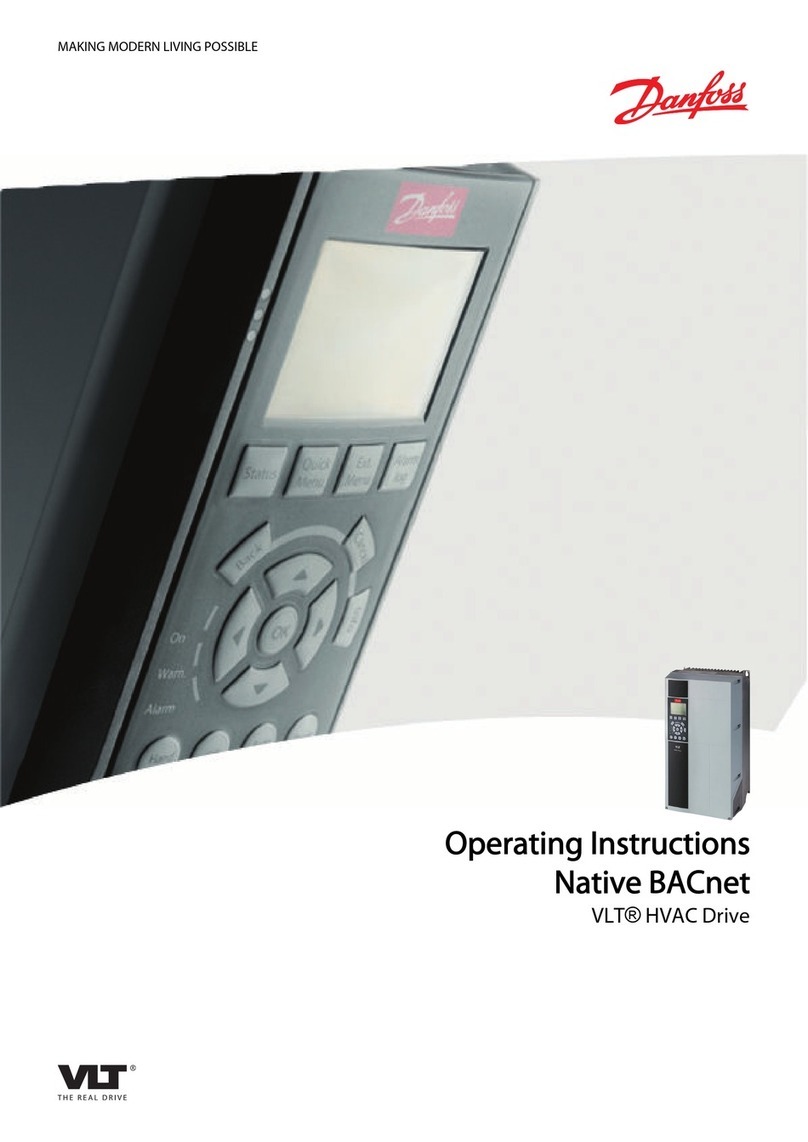
Danfoss
Danfoss Native BACnet VLT HVAC Drive operating instructions

Eaton
Eaton GVX9000 quick start guide
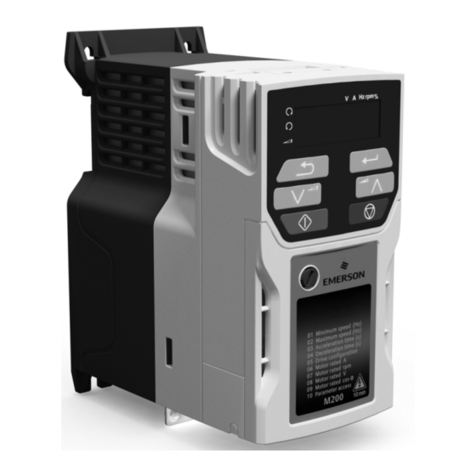
Emerson
Emerson Unidrive M200-01100017 quick start guide

Danfoss
Danfoss VLT AQUA Drive FC 202 Design guide
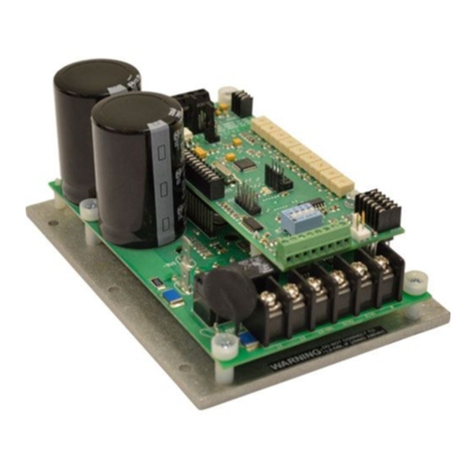
American Control Electronics
American Control Electronics Minarik Drives MDBL05 manual

